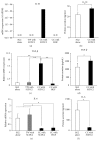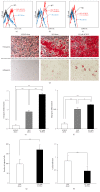Enhancement of Anti-Inflammatory and Osteogenic Abilities of Mesenchymal Stem Cells via Cell-to-Cell Adhesion to Periodontal Ligament-Derived Fibroblasts
- PMID: 28167967
- PMCID: PMC5266859
- DOI: 10.1155/2017/3296498
Enhancement of Anti-Inflammatory and Osteogenic Abilities of Mesenchymal Stem Cells via Cell-to-Cell Adhesion to Periodontal Ligament-Derived Fibroblasts
Abstract
Mesenchymal stem cells (MSCs) are involved in anti-inflammatory events and tissue repair; these functions are activated by their migration or homing to inflammatory tissues in response to various chemokines. However, the mechanism by which MSCs interact with other cell types in inflammatory tissue remains unclear. We investigated the role of periodontal ligament fibroblasts (PDL-Fs) in regulating the anti-inflammatory and osteogenic abilities of bone marrow-derived- (BM-) MSCs. The expression of monocyte chemotactic protein- (MCP-)1 was significantly enhanced by stimulation of PDL-Fs with inflammatory cytokines. MCP-1 induced the migratory ability of BM-MSCs but not PDL-Fs. Expression levels of anti-inflammatory and inflammatory cytokines were increased and decreased, respectively, by direct-contact coculture between MSCs and PDL-Fs. In addition, the direct-contact coculture enhanced the expression of MSC markers that play important roles in the self-renewal and maintenance of multipotency of MSCs, which in turn induced the osteogenic ability of the cells. These results suggest that MCP-1 induces the migration and homing of BM-MSCs into the PDL inflammatory tissue. The subsequent adherence of MSCs to PDL-Fs plays an immunomodulatory role to terminate inflammation during wound healing and upregulates the expression stem cell markers to enhance the stemness of MSCs, thereby facilitating bone formation in damaged PDL tissue.
Conflict of interest statement
The authors declare that they have no competing interests.
Figures




Similar articles
-
Functional interleukin-7/interleukin-7Ralpha, and SDF-1alpha/CXCR4 are expressed by human periodontal ligament derived mesenchymal stem cells.J Cell Physiol. 2008 Mar;214(3):706-13. doi: 10.1002/jcp.21266. J Cell Physiol. 2008. PMID: 17894415
-
Recruitment of bone marrow-derived cells to the periodontal ligament via the stromal cell-derived factor-1/C-X-C chemokine receptor type 4 axis.J Periodontal Res. 2017 Aug;52(4):686-694. doi: 10.1111/jre.12433. Epub 2017 Feb 8. J Periodontal Res. 2017. PMID: 28177531
-
Comparison of mesenchymal stem cells isolated from pulp and periodontal ligament.J Periodontol. 2015 Feb;86(2):283-91. doi: 10.1902/jop.2014.140257. Epub 2014 Oct 17. J Periodontol. 2015. PMID: 25325708
-
Detection, Characterization, and Clinical Application of Mesenchymal Stem Cells in Periodontal Ligament Tissue.Stem Cells Int. 2018 Aug 26;2018:5450768. doi: 10.1155/2018/5450768. eCollection 2018. Stem Cells Int. 2018. PMID: 30224921 Free PMC article. Review.
-
Periodontal tissue stem cells and mesenchymal stem cells in the periodontal ligament.Jpn Dent Sci Rev. 2022 Nov;58:172-178. doi: 10.1016/j.jdsr.2022.04.001. Epub 2022 May 17. Jpn Dent Sci Rev. 2022. PMID: 35607404 Free PMC article. Review.
Cited by
-
Two novel mechanisms for maintenance of stemness in mesenchymal stem cells: SCRG1/BST1 axis and cell-cell adhesion through N-cadherin.Jpn Dent Sci Rev. 2018 Feb;54(1):37-44. doi: 10.1016/j.jdsr.2017.10.001. Epub 2017 Nov 9. Jpn Dent Sci Rev. 2018. PMID: 29629000 Free PMC article. Review.
-
Forkhead box O1 (FOXO1) controls the migratory response of Toll-like receptor (TLR3)-stimulated human mesenchymal stromal cells.J Biol Chem. 2019 May 24;294(21):8424-8437. doi: 10.1074/jbc.RA119.008673. Epub 2019 Apr 3. J Biol Chem. 2019. PMID: 30944148 Free PMC article.
-
FLT1-enriched extracellular vesicles induce a positive feedback loop between nasopharyngeal carcinoma cells and endothelial cells to promote angiogenesis and tumour metastasis.Oncogene. 2025 Jul;44(27):2253-2267. doi: 10.1038/s41388-025-03389-x. Epub 2025 Apr 13. Oncogene. 2025. PMID: 40223024
-
Immunomodulatory functions of human mesenchymal stromal cells are enhanced when cultured on HEP/COL multilayers supplemented with interferon-gamma.Mater Today Bio. 2021 Dec 23;13:100194. doi: 10.1016/j.mtbio.2021.100194. eCollection 2022 Jan. Mater Today Bio. 2021. PMID: 35005599 Free PMC article.
-
Treatment of an endodontic-periodontal lesion using peripheral blood mesenchymal stem cells (PBMSCs) and platelet-rich fibrin matrix (PRFM): A case report.J Adv Periodontol Implant Dent. 2025 Mar 8;17(1):54-58. doi: 10.34172/japid.025.3502. eCollection 2025 Mar. J Adv Periodontol Implant Dent. 2025. PMID: 40265038 Free PMC article.
References
-
- Friedenstein A. J., Chailakhjan R. K., Lalykina K. S. The development of fibroblast colonies in monolayer cultures of guinea-pig bone marrow and spleen cells. Cell and Tissue Kinetics. 1970;3(4):393–403. - PubMed
LinkOut - more resources
Full Text Sources
Other Literature Sources
Miscellaneous

